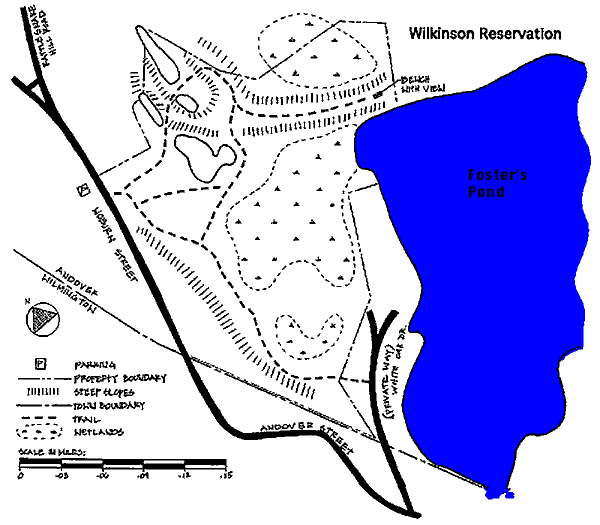Wilkinson Reservation
Andover Village Improvement Society
Size: 23 acres
Parking:Along Woburn St., just south of Rattlesnake Hill Rd.

History
Wilkinson Reservation was given to AVIS in 1981 by Irvin and Marsha Wilkinson, to be preserved and cared for. Their son, David, a science teacher at Andover High School, used this geologically interesting property as a laboratory for his students.
Natural features
The glaciers that covered Andover 10,000-12,000 years ago shaped the topography of Wilkinson Reservation. There are numerous small kettlehole ponds here. These were created as the glaciers receded, when blocks of ice were left behind in the outwash plains. These ice blocks melted, forming depressions. If these depressions were below the water table, they filled with water, becoming kettlehole ponds.
Narrow trails through white oaks and tall white and red pines wind along eskers, up and down from one kettlehole pond to another. Eskers are ridges of rocks and coarse gravel that were deposited by meltwater streams flowing through crevices and tunnels in the glacier. They can be as high as 100 feet and several miles long. Wilkinson Reservation contains several lower but steeply banked eskers.
A ridge overlooking the marshy end of Foster's Pond offers birdwatching opportunities. A sturdy bench built by an Eagle Scout provides a comfortable resting spot. A mating pair of blue herons has been observed here, and an osprey has been sighted in an impressive grove of graceful hemlocks.
In spring, Wilkinson woodlands are filled with lady slippers, trilliums, white swamp azaleas, pinks, mountain laurel and many more wildflowers and flowering shrubs. The kettlehole ponds are home to several species of frogs and other amphibians.
Though not large, this reservation is rich in geological interests, wildflowers, and lovely trees.
-- from The Bay Circuit and AVIS Guide to Walks in Andover (1992)


 Questions? Comments? Contact us at
Questions? Comments? Contact us at